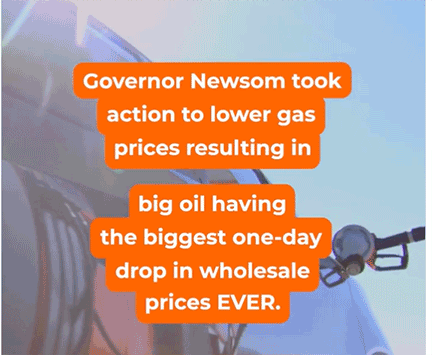California Gas Prices: Governor Newsom Seeks Industry Collaboration To Lower Costs

Table of Contents
Understanding the Current California Gas Price Crisis
Factors Contributing to High Prices
California's high gas prices are a complex issue with multiple contributing factors. Understanding these elements is crucial to developing effective solutions.
-
Global Oil Market Fluctuations and Geopolitical Instability: Global events, such as wars and political instability in oil-producing regions, significantly impact the price of crude oil, the primary component of gasoline. These fluctuations directly translate to higher prices at the pump in California.
-
California's Unique Gasoline Blend Regulations (CARB Standards): California's stringent environmental regulations, enforced by the California Air Resources Board (CARB), mandate the use of a unique gasoline blend with lower emissions. This specialized blend is more expensive to produce than the gasoline used in other states.
-
High State and Federal Taxes: California has some of the highest state and federal gas taxes in the nation. These taxes contribute significantly to the overall cost of gasoline for consumers.
-
Limited Refinery Capacity in California: California has a limited number of refineries compared to its population and demand. This limited capacity makes the state more vulnerable to supply disruptions and price increases.
-
Supply Chain Disruptions and Transportation Costs: Disruptions to the supply chain, including transportation delays and increased shipping costs, can further exacerbate the already high gas prices.
The Impact on Californians
The high cost of gasoline has far-reaching consequences for California residents and the state's economy.
-
Increased Cost of Living, Impacting Household Budgets: Higher gas prices directly increase the cost of commuting, shopping, and other daily activities, putting a strain on household budgets. Many Californians are forced to make difficult choices between essential needs.
-
Higher Transportation Costs for Businesses, Potentially Affecting Prices of Goods and Services: Businesses rely heavily on transportation for the delivery of goods and services. Rising gas prices increase operational costs, which can lead to higher prices for consumers.
-
Economic Strain on Low-Income Families: Low-income families are disproportionately affected by high gas prices, as transportation costs represent a larger portion of their income.
-
Potential for Reduced Consumer Spending: The increased cost of living due to high gas prices may lead to reduced consumer spending, potentially impacting economic growth.
Governor Newsom's Approach: Seeking Industry Collaboration
The Governor's Proposed Solutions
Governor Newsom's approach focuses on increasing transparency and collaboration with the oil industry to find sustainable solutions.
-
Increased Transparency from Oil Companies Regarding Pricing Practices: The Governor is pushing for greater transparency in the oil industry's pricing practices to identify and address potential irregularities.
-
Investigations into Potential Price Gouging: Investigations are underway to determine whether oil companies are engaging in price gouging, taking advantage of the situation to inflate profits.
-
Incentivizing Increased Refinery Production within California: The Governor is exploring incentives to encourage increased refinery production within the state to help alleviate supply constraints.
-
Exploring Alternative Fuel Sources and Infrastructure Development: Investing in alternative fuel sources, such as electric vehicles and renewable fuels, is crucial for long-term sustainability and price stability.
-
Collaboration with Industry Stakeholders to Find Sustainable Solutions: Governor Newsom emphasizes the importance of collaboration between the government, the oil industry, and other stakeholders to develop comprehensive solutions.
The Industry's Response
The oil industry's response to the Governor's initiatives is varied. Some companies express a willingness to collaborate, while others highlight the complexities of the global oil market and the challenges of increasing refinery capacity. Discussions are ongoing to find common ground and develop effective strategies.
Potential Long-Term Solutions for Affordable California Gas Prices
Investing in Renewable Energy Sources
Transitioning to renewable energy sources is a critical long-term strategy to reduce reliance on fossil fuels and improve energy independence.
-
Exploring the Viability of Electric Vehicles and Charging Infrastructure: Investing in electric vehicle (EV) infrastructure and incentivizing EV adoption is crucial for reducing gasoline demand.
-
Investing in Renewable Fuel Alternatives like Biofuels: Developing and utilizing renewable fuel alternatives, such as biofuels, can provide a more sustainable and potentially less expensive energy source.
-
Government Incentives and Subsidies to Promote Clean Energy Adoption: Government incentives and subsidies can play a vital role in accelerating the adoption of clean energy technologies.
Reforming California's Gasoline Regulations
Re-evaluating California's stringent gasoline regulations is necessary to strike a balance between environmental protection and affordability.
-
Evaluating the Balance Between Environmental Protection and Affordability: Finding a balance between protecting the environment and ensuring affordable energy for consumers is a key challenge.
-
Analyzing the Potential Impact of Changes to CARB Standards: Any changes to CARB standards must be carefully analyzed to ensure that they don't compromise environmental goals.
-
Exploring Phased Implementation of More Stringent Regulations: A phased approach to implementing stricter regulations may allow for a more gradual transition and minimize economic disruption.
Improving Refinery Capacity
Increasing California's refinery capacity could help alleviate supply constraints and reduce price volatility.
-
Incentivizing the Construction of New Refineries: Government incentives and streamlined permitting processes can encourage the construction of new refineries.
-
Modernizing Existing Refineries to Increase Efficiency: Modernizing existing refineries can improve efficiency and increase production capacity.
-
Addressing Environmental Concerns Related to Refinery Expansion: Environmental concerns must be carefully addressed to ensure that refinery expansion projects are sustainable and environmentally responsible.
Conclusion
High California gas prices pose a substantial challenge to the state's residents and economy. Governor Newsom's push for industry collaboration is a vital step towards finding effective solutions. Tackling this multifaceted issue demands a comprehensive approach encompassing transparency, investigation, sustainable solutions, and long-term investments in renewable energy. Staying informed about developments regarding California gas prices, engaging in community discussions, and advocating for policies that promote affordable and sustainable energy are crucial for securing a brighter energy future for all Californians. Continue to monitor updates on this critical issue and actively participate in shaping the future of California gas prices and energy independence.

Featured Posts
-
 Open Ai Faces Ftc Probe Examining The Future Of Ai Accountability
Apr 24, 2025
Open Ai Faces Ftc Probe Examining The Future Of Ai Accountability
Apr 24, 2025 -
 Ai Drives Sk Hynix Past Samsung In Dram Market Share
Apr 24, 2025
Ai Drives Sk Hynix Past Samsung In Dram Market Share
Apr 24, 2025 -
 Usd Strengthens Dollar Gains Against Major Currencies As Trump Softens Stance On Fed
Apr 24, 2025
Usd Strengthens Dollar Gains Against Major Currencies As Trump Softens Stance On Fed
Apr 24, 2025 -
 John Travolta Honors Late Son Jett On His Birthday With A Shared Photo
Apr 24, 2025
John Travolta Honors Late Son Jett On His Birthday With A Shared Photo
Apr 24, 2025 -
 Instagram Launches Video Editor To Attract Tik Tok Creators
Apr 24, 2025
Instagram Launches Video Editor To Attract Tik Tok Creators
Apr 24, 2025
